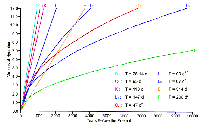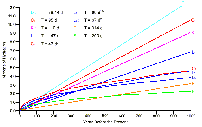Obsidian Butte Hydration Rate
Obsidian hydration measurements are widely used for absolute or relative dating, although their validity is still somewhat controversial. The method is based on the gradual inward extension of a water-bearing zone, or hydration rim, from a freshly exposed surface of volcanic glass. The thickness of the hydration rim is microscopically measurable in cross section. Factors that are known or suspected to affect the rate of hydration rim growth include the chemical composition of the obsidian, its intrinsic water content, the effective hydration temperature (which may reflect both the mean temperature and the annual temperature range), ambient humidity, and the exposure of the specimen on the ground surface or its subsurface burial. An error factor on the order of ±0.2 microns in making hydration measurements is generally reported.
Obsidian is only a minor element in the lithic assemblages of prehistoric sites in San Diego County. However, several factors encourage the development a local chronology based on obsidian hydration. These include the relatively low unit cost of hydration measurements, the presence of obsidian in some archaeological deposits that lack materials suitable for radiocarbon dating, and the possibility of giving a fairly direct cultural interpretation to the exposure of a flaked surface and to the presence of this locally exotic material at a site.
The Obsidian Butte source, located near the southern shore of the Salton Sea in Imperial County, is the nearest known obsidian source for San Diego County. Obsidian from Obsidian Butte accounts for most of the obsidian in Late Prehistoric assemblages in San Diego County, but it is scarce in earlier assemblages, in which obsidian from the more distant Coso Volcanic Fields source in Inyo County predominates (cf. Hughes and True 1985).
The chronology of Obsidian Butte’s exploitation is intimately linked with the chronology of prehistoric Lake Cahuilla. The obsidian source area, lying between 40 and 70 meters below sea level, was submerged when the lake was present, during several portions of the Late Prehistoric Period and during earlier periods as well (Laylander 1997; Love and Dahdul 2002; Waters 1983). The obsidian flow itself is generally believed to date from the late Pleistocene Epoch (Friedman and Obradovich 1981; Kelley and Soske 1936; Miller 1989; Muffler and White 1969).
Different mathematical models have been suggested for the rate of hydration. Particularly favored have been the linear model (T = k d, in which T is the time in years which elapsed between exposure and measurement, d is the thickness of the hydration rim in microns, and k is a calibration constant) and the diffusion model (T = k d 2).
Several formulas to calibrate Obsidian Butte hydration measurements have been proposed. These rates give widely different interpretations to individual readings, and no consensus formula exists at present.
 Paul G. Chace suggested a linear rate, corresponding to T = 95 d. Chace’s rate was based in part on 18 readings from the Nelson Site (SDI-5680) in western San Diego County and in part on a collection of 540 readings “from 34 different sites in or near San Diego County” (Chace 1980:9). Chace’s readings were on unsourced obsidian; it was assumed that most of the obsidian came from Obsdian Butte, with perhaps some of the larger hydration readings being attributable to material from the Coso Volcanic Fields source or to geologically exposed surfaces on Obsidian Butte material. To construct his rate, Chace used four fixed calibration points: 0.0 microns for the present; 1.4 microns for A.D. 1860, which he took to mark the final end of the aboriginal obsidian trade; 2.0 microns for A.D. 1780, the peak of the obsidian trade; and 3.8 microns for A.D. 1600, which was thought to be when the Obsidian Butte source became accessible after the recession of Lake Cahuilla. Dennis O’Neil (1984) reported that Chace also suggested a diffusion rate formula, T = 47 d 2.
Paul G. Chace suggested a linear rate, corresponding to T = 95 d. Chace’s rate was based in part on 18 readings from the Nelson Site (SDI-5680) in western San Diego County and in part on a collection of 540 readings “from 34 different sites in or near San Diego County” (Chace 1980:9). Chace’s readings were on unsourced obsidian; it was assumed that most of the obsidian came from Obsdian Butte, with perhaps some of the larger hydration readings being attributable to material from the Coso Volcanic Fields source or to geologically exposed surfaces on Obsidian Butte material. To construct his rate, Chace used four fixed calibration points: 0.0 microns for the present; 1.4 microns for A.D. 1860, which he took to mark the final end of the aboriginal obsidian trade; 2.0 microns for A.D. 1780, the peak of the obsidian trade; and 3.8 microns for A.D. 1600, which was thought to be when the Obsidian Butte source became accessible after the recession of Lake Cahuilla. Dennis O’Neil (1984) reported that Chace also suggested a diffusion rate formula, T = 47 d 2.
- Irving Friedman and John Obradovich (1981) proposed an extremely slow diffusion formula, T = 200 d 2. This proposal was based on matching an index for Obsidian Butte’s major-element chemical composition (silicon, calcium, magnesium, and water) and the mean annual soil temperature (at Brawley in Imperial County) with experimentally derived hydration curves, rather than on any archaeological evidence.
- Debra A. Dominici (1984) proposed a linear formula slightly faster than Chace’s, T = 78.14 d. Following the approach used by Chace, Dominici based her rate primarily on independent estimates of events relating to the presence or absence of Lake Cahuilla and the historic-period end of obsidian use, which were matched against the regional patterns in hydration measurement frequencies. The frequency patterns were considered to be more compatible with a linear hydration curve than with any of the other curve forms suggested by Jonathon E. Ericson (1977). Given the rate’s linear form, three relatively large hydration readings were used to derive the hydration constant. A reading of 9.7 microns from site SDI-813 in Anza-Borrego Desert State Park was thought to coincide with A.D. 1210, which had been suggested by Michael R. Waters (1983) as the date of a hiatus between two stands of Lake Cahuilla. A reading of 6.7 microns from SDI-674 in western San Diego County was considered to coincide with A.D. 1420, suggested by Waters as another hiatus between two lake stands. A reading of 5.8 microns on a utilized flake from SDM-C-89 was the largest reading on a sample of specimens from the San Diego Museum of Man. This was considered by Dominici to coincide with A.D. 1575, taken to mark the final recession of Lake Cahuilla. Dominici averaged the three estimates to derive an hydration constant of 78.16 years per micron.
- Elizabeth Coughlin and Ericson proposed a relatively slow linear formula, T = 314 d, according to Jan Townsend (1986). Ericson was also reported as having proposed the similar rate of T = 300 d (McFarland 2000).
- Henry C. Koerper, Ericson, Christopher E. Drover, and Paul E. Langenwalter (1986) proposed another linear formula, T = 110 d. The proposal was based on readings on sourced obsidian specimens recovered from an Orange County site, ORA-855. The specimens had a maximum hydration reading of 2.0 microns, a mean reading of about 1.64 microns, and a standard deviation of 0.25 microns. The radiocarbon dates at the site seemed to point to an eighteenth-century occupation. According to the proponents, “Obsidian Butte material at CA-ORA-855 would have been exploited perhaps no earlier than a late 17th century A.D. [Lake Cahuilla] water drawdown” (Koerper et al. 1986:53).
- Based on studies at the Elmore Site (IMP-6427) in western Imperial County, occupied briefly during the final stages of Lake Cahuilla, Don Laylander (1994) proposed that a mean hydration reading of 2.2 microns on subsurface specimens from the site corresponded to a pooled, calibrated radiocarbon date of about A.D. 1669. Hydration formulas based on this single calibration point were T = 147 d, T = 67 d 2, and T = 99 d 1.5. Laylander also suggested that the spread of hydration readings at the site argued for a one-sigma error factor of ±0.36 (or ±16%, or ±50 years), under these favorable conditions. Hydration readings on specimens from the surface of the same site were both substantially larger and substantially less consistent.
- Sharon McFarland (2000) collected hydration readings on 715 specimens that were chemically sourced to Obsidian Butte and recovered in San Diego County sites. The distribution seemed to favor a diffusion formula (T = k d 2), assuming that there was at least some exploitation of the source prior to the Late Prehistoric period and also assuming that its use had not dramatically declined prior to Spanish contact. Linear rates (T = k d) either effectively ruled out any early use (Chace, Dominici, Koerper et al., Laylander) or ruled out most or all use during the final prehistoric centuries (Ericson). The diffusion formula of Friedman and Obradovich seemed to give unacceptably early dates from large hydration readings, but the diffusion formulas of Chace and Laylander provided more credible results.
An alternative approach to calibrating hydration readings is basen on the intrinsic water content of individual obsidian specimens as estimated from their density, rather than on an empirically derived rate for obsidian from a specific geological source (Stevenson et al. 1998, 2000). This approach seems to have been little explored in San Diego County, and it is not clear how credible its results are in comparison with alternative methods (e.g., Russell 1999).
PROSPECTS
Future archaeological research may be able to pin down the optimal form for a calibration curve, the calibration constants, the environmental factors affecting the rate, the best ways to compensate for those factors, and the size of the error factor in hydration dates.